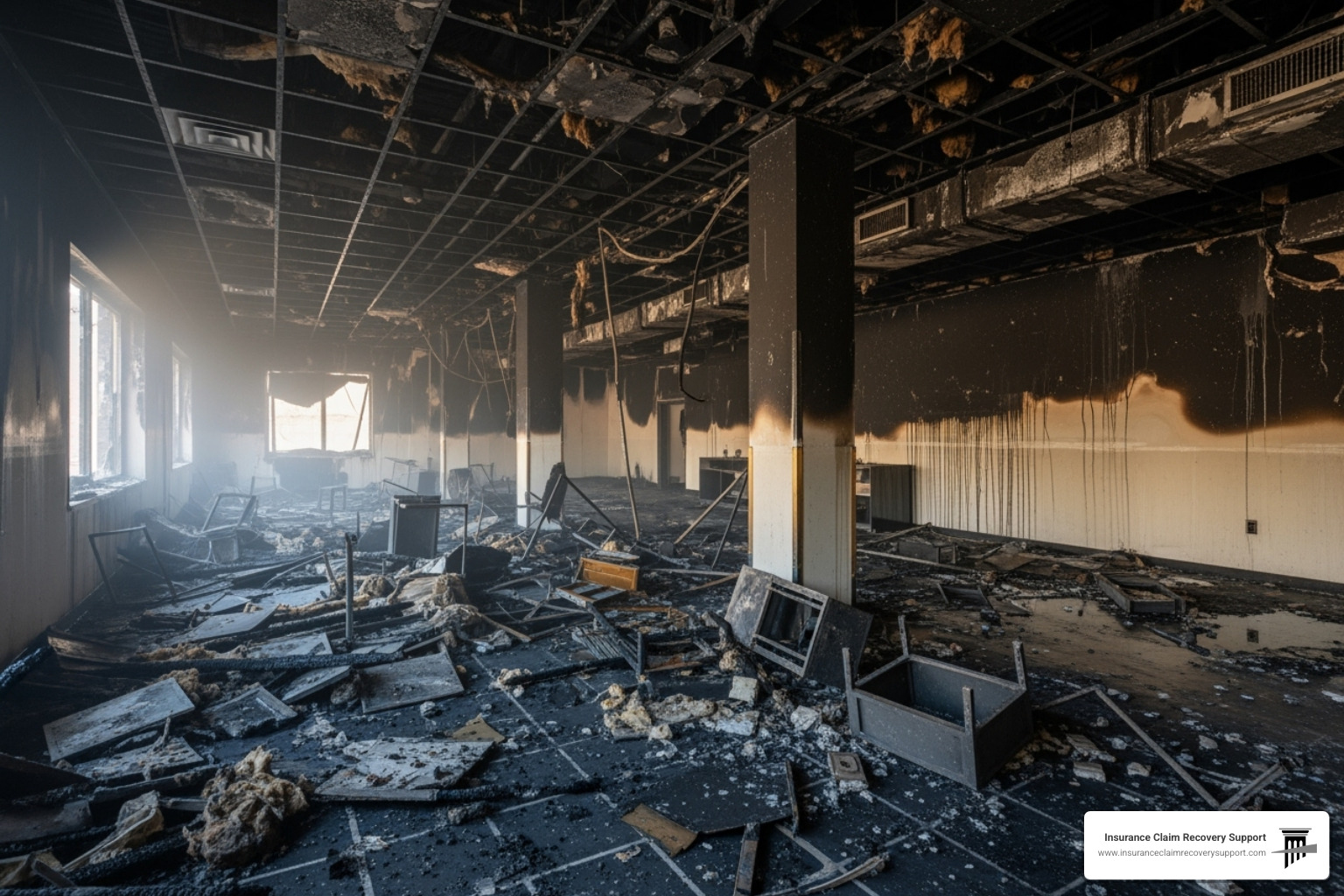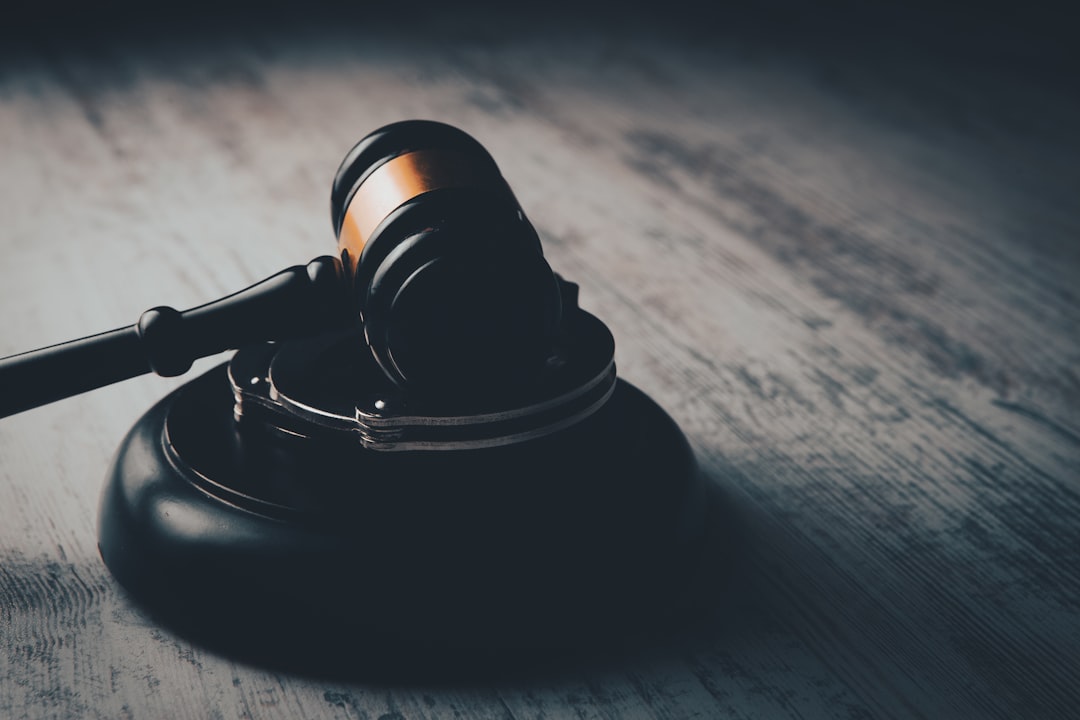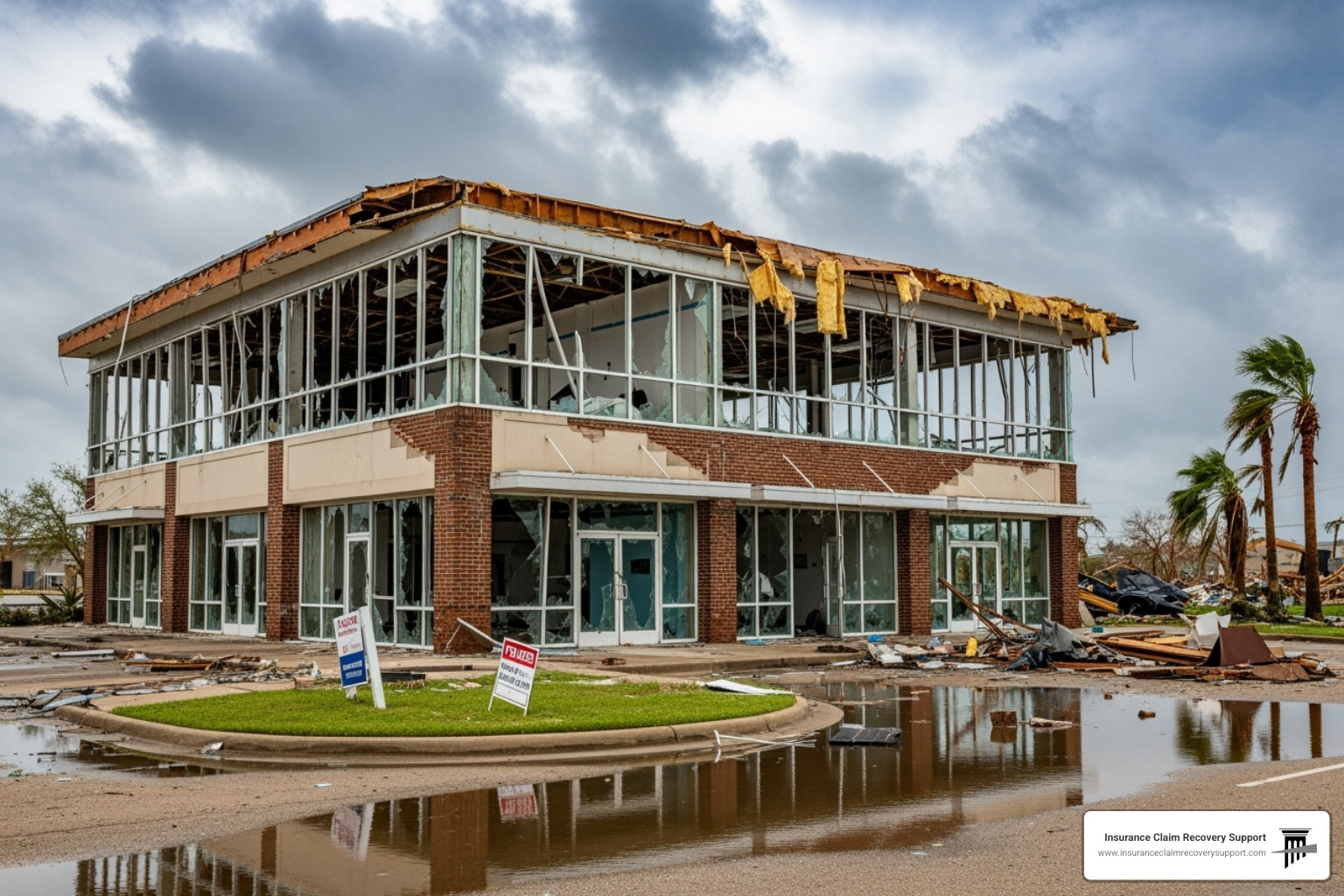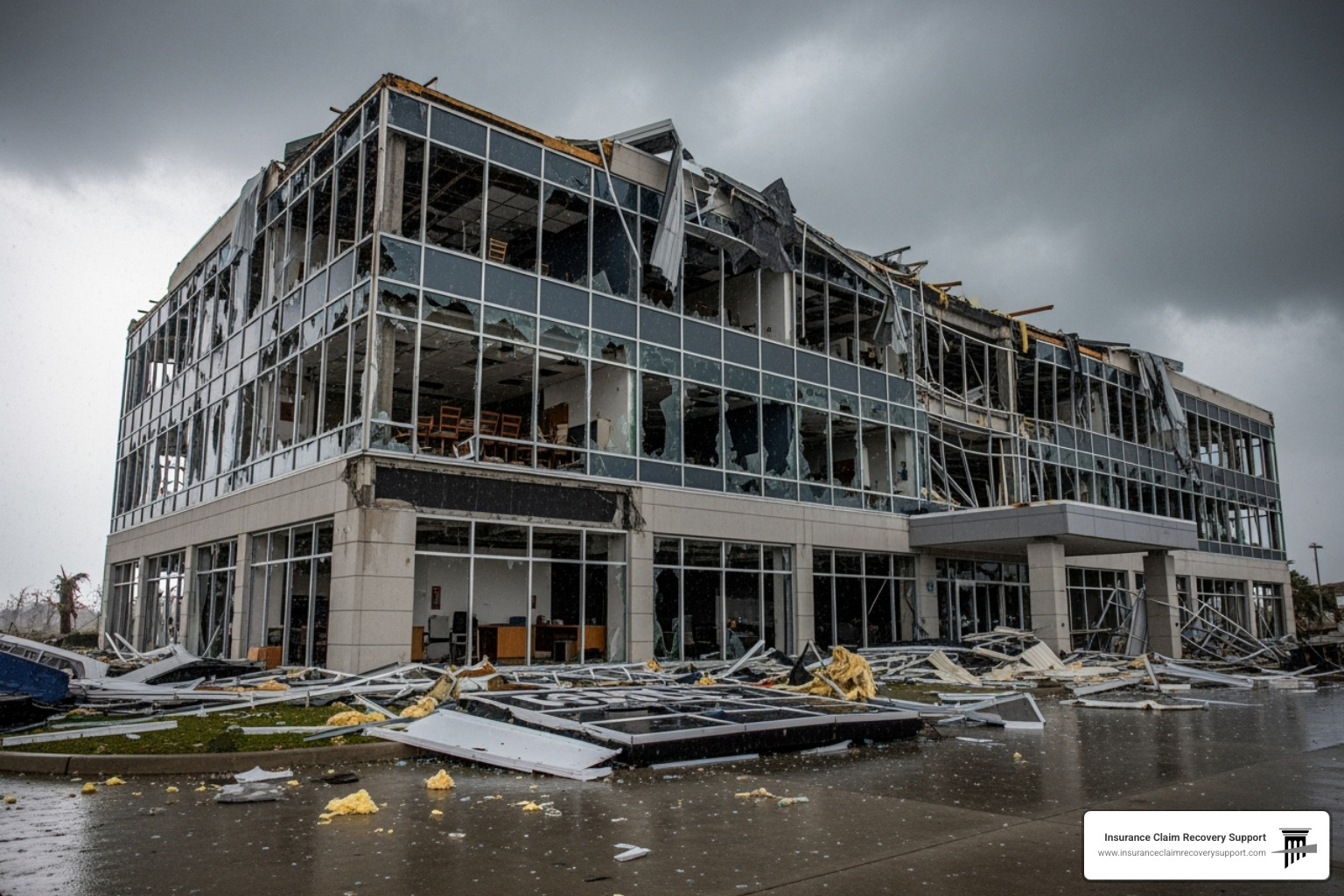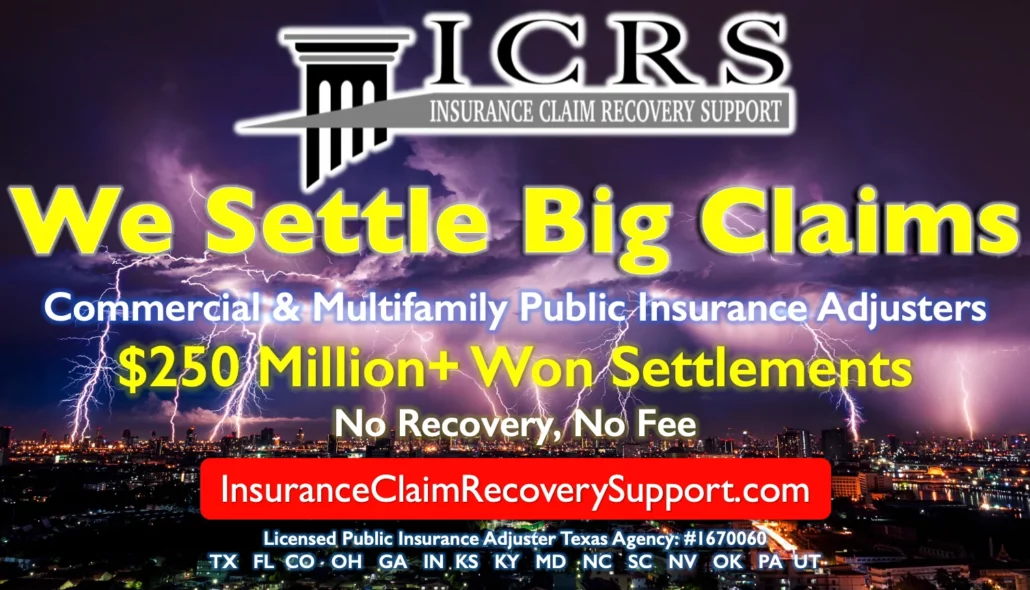Introduction: The Hidden Threat of Smoke to Your Commercial Property
A smoke damage insurance claim can be a challenging process. When fire strikes a commercial building or multifamily complex, the flames are just the beginning. Smoke, soot, and ash cause pervasive damage that reaches far beyond the initial fire zone.
To file a smoke damage insurance claim, follow these steps:
- Notify Your Insurer: Contact your insurance company immediately to report the damage.
- Document Everything: Take clear photos and videos of all affected areas. Make a detailed list of damages.
- Prevent Further Damage: Make safe, temporary repairs. Do not attempt extensive cleaning yourself, as this can worsen damage or pose health risks.
- Keep Records: Save all receipts for related expenses, like temporary lodging or supplies.
- Seek Professional Help: Consider hiring a public adjuster for complex claims to ensure a fair settlement.
This hidden damage etches surfaces, corrodes metals, and leaves persistent odors. Microscopic smoke particles spread through HVAC systems, infiltrating every corner of your property.
Beyond physical damage, smoke and soot carry serious health risks, including exposure to carcinogens and respiratory issues for occupants. For property owners, this means significant financial loss, tenant health liabilities, and complex insurance negotiations. Understanding this process is crucial.
I’m Scott Friedson, CEO of ICRS LLC and a multi-state licensed public adjuster. I’ve helped policyholders settle hundreds of millions in commercial and multifamily property damage insurance claims, including complex smoke damage insurance claim cases.

Understanding the Full Scope of Smoke Damage
Smoke damage is more than a bad smell; it’s a complex chemical reaction. Tiny particles of ash and soot released by a fire can infiltrate your building through HVAC units, vents, and even small cracks. This means smoke can travel far from the fire’s source, affecting areas that seem untouched.
Once inside, smoke particles mix with humidity to create corrosive residues that etch, pit, and burn surfaces like paint, wood, and metal. Left untreated, this leads to costly long-term damage. Delaying smoke damage restoration increases the risk of irreversible harm and higher repair bills. Professional technicians can spot this hidden, pervasive damage early.
The Critical Difference Between Smoke and Fire Damage
Fire damage is obvious—charred beams, melted materials. Smoke damage is insidious, a quiet contamination spreading far beyond the fire zone. It leaves behind microscopic, corrosive particles invisible to the naked eye.
A small fire in one apartment can spread smoke damage throughout a building via the HVAC system, causing surface discoloration, hidden damage in walls, and persistent odors. Water from firefighting efforts adds another layer of complexity to your smoke damage insurance claim. Unlike obvious fire destruction, proving the full extent of smoke damage requires expert assessment and often becomes a point of contention in a claim.
Health Risks and Why They Matter for Your Claim
The health risks of smoke and ash exposure are a vital part of your smoke damage insurance claim. A single fire can release thousands of carcinogens, and lingering smoke can cause serious respiratory problems.
Here are some of the critical health risks:
- Respiratory Problems: Exposure to smoke and soot increases the risk of bronchitis, asthma, and other chronic respiratory issues as particles irritate airways.
- Carcinogens: Soot contains toxic chemicals that, when inhaled or absorbed, increase the risk of various cancers. Even short-term exposure can have lifelong health consequences.
- Cardiovascular Issues: Inhaling smoke is linked to an increased risk of heart attacks and strokes.
- Toxic Gases: Damaged sewage pipes can release toxic gases, causing dizziness and nausea.
- Contamination: Toxic soot mixed with firefighting water creates a harmful sludge, posing additional health risks.
- Impact on Pets: Soot is also dangerous for pets, causing similar respiratory and ingestion risks.
These health implications are critical for your smoke damage insurance claim, underscoring the need for professional cleaning and air quality testing. An unsafe property impacts business interruption and additional living expenses (ALE) claims and creates liability concerns for owners. Thorough remediation and documentation are crucial. For more details, you can refer to scientific research on health effects of soot exposure.
Decoding Your Insurance Policy: What’s Covered and What’s Not
Your insurance policy is your roadmap for a smoke damage insurance claim, but most owners don’t read it until disaster strikes—a costly mistake. Go beyond the declarations page; get the complete policy document. It details the covered perils, limits, and deductibles that determine your recovery amount.
Most commercial policies cover smoke damage under the fire coverage section as a “sudden and accidental” peril. However, the specific details are what make or break a claim.
Typical Coverage for Smoke Damage
Your policy likely includes several types of coverage for smoke damage:
- Structure coverage protects the physical building—walls, ceilings, floors, and structural components. It applies when smoke penetrates surfaces, discolors paint, or corrodes wiring.
- Contents and personal property coverage protects items inside, like furniture, equipment, and inventory. Smoke can contaminate fabrics and ruin electronics, often requiring professional cleaning or replacement.
- Business interruption coverage is crucial for commercial and multifamily properties. It replaces lost income and covers operating expenses if smoke damage forces a shutdown or makes units uninhabitable.
- Additional living expenses (ALE) covers temporary housing and other costs for displaced tenants when units are unlivable due to smoke damage, which can also protect you from liability.
- Debris removal coverage pays for removing damaged materials, contaminated items, and other debris from the restoration.
Common Exclusions and Policy Pitfalls
Be aware of common exclusions insurers use to limit payouts on a smoke damage insurance claim:
- Gradual damage exclusions for issues like long-term cigarette smoke are often misapplied by insurers to sudden fire events.
- Pollution exclusions are sometimes used by insurers who argue smoke and soot are pollutants. This is a common dispute area requiring expert policy interpretation.
- Odor-only coverage can be an issue. Some policies may deny claims for persistent odors without visible damage, making professional tests that prove contamination essential.
- Mold limitations are common, as firefighting water can cause mold within 24-48 hours. Policies often have low limits or exclusions, but you may have coverage if mold results from insurer delays.
- Maintenance-related exclusions may be used if an insurer can link the damage to poor maintenance. Good property records are your best defense.
Insurers aim to minimize payouts, interpreting policy language to their benefit. A public adjuster advocates for you, interpreting the policy in your favor to fight for the coverage you deserve.
Your First 48 Hours: A Step-by-Step Action Plan
The first 48 hours after a fire are chaotic but critical for your smoke damage insurance claim. After ensuring the property is safe to enter, your priorities are to secure the area and document everything.

Key Documentation for Your Smoke Damage Insurance Claim
Documentation is vital for a strong smoke damage insurance claim and helps your public adjuster fight for a maximum settlement. Here’s what to gather:
- Official Reports: Get copies of police and fire reports for an objective account of the incident.
- Photos and Videos: Take extensive photos and videos of all damage before any cleanup. Capture visible smoke, soot, and water damage, including hidden areas like attics and HVAC vents. Pre-loss photos are invaluable for showing the property’s prior condition.
- Swipe Test: To document subtle smoke damage, wipe a clean white cloth across a surface and photograph the residue.
- Detailed Inventory: Create a list of all damaged items, including equipment and inventory. Note the item’s age, purchase price, and replacement cost.
- Receipts: Save all receipts for expenses related to the damage, such as temporary repairs or tenant housing.
- Communications Log: Keep a detailed record of all communications with your insurer, adjusters, and contractors.
- Professional Damage Report: Obtain a report from a certified remediation company for an expert assessment of the damage.
Don’t throw away anything damaged until your insurer has seen it and given you written permission. This is crucial!
Mitigating Further Damage (Without Harming Your Claim)
As a policyholder, you have a “duty to mitigate”—taking reasonable steps to prevent further damage. However, improper mitigation can harm your smoke damage insurance claim. Here’s how to strike the right balance:
- Hire Professionals: Immediately hire a professional fire and smoke damage restoration company. They have the expertise and tools to find hidden contamination, neutralize odors, and prevent secondary issues like mold.
- Shut Down Your HVAC System: Turn off your heating and cooling system to prevent smoke and soot from spreading. It must be professionally cleaned before being used again.
- Do Not DIY Clean: Avoid cleaning yourself. Smoke and soot residues are complex and often acidic. Using the wrong methods can cause permanent damage, spread contaminants, and pose serious health risks.
- Make Temporary Repairs: Focus on temporary repairs to secure your property, like boarding up windows or covering the roof. Save all receipts and avoid permanent repairs until your insurer has inspected the damage.
Mastering the Smoke Damage Insurance Claim Process
The smoke damage insurance claim process is overwhelming. Insurers have their own adjusters and procedures, but their assessments often miss the full extent of losses, especially with hard-to-detect smoke damage. Understanding the process empowers you to secure a fair settlement.

The Adjuster’s Role: Who Advocates for You?
In a smoke damage insurance claim, you’ll encounter different types of adjusters. Knowing who works for you is key to your final settlement.
| Feature | Insurance Company Adjuster | Public Adjuster |
|---|---|---|
| Employer | Insurance company | Policyholder |
| Loyalty | To the insurance company’s interests (minimizing payouts) | To the policyholder’s interests (maximizing settlement) |
| Goal | To assess damage and determine the company’s liability under the policy | To assess damage, interpret policy, and negotiate for the policyholder’s maximum benefit |
| Cost | Included in your insurance premium | Typically a contingency fee (percentage of the settlement) |
| Expertise | Familiar with company procedures and policy interpretation | Expert in policy language, claim estimation, and negotiation |
| Conflict of Interest | Inherent conflict, as they represent the payer | None, as they exclusively represent the claimant |
The insurance company’s adjuster works to protect the insurer’s bottom line. Their assessments can lead to lower settlement offers by missing hidden damage or underestimating remediation costs.
A public adjuster works exclusively for you. As licensed professionals, we find all damage and fight for the highest settlement. For complex claims, an advocate can dramatically increase your final payout.
Common Disputes in a Smoke Damage Insurance Claim and How to Win Them
Smoke damage insurance claims often lead to disputes due to subtle, widespread damage. Here are common issues and how we help clients win:
- Cleaning vs. Replacement: Insurers prefer cheaper cleaning, but many items can’t be fully restored. Porous materials, electronics, and items with lingering odors often require full replacement, which we fight for.
- Depreciation: Insurers may offer “actual cash value” (depreciated worth). If you have replacement cost coverage, we fight unfair depreciation by documenting pre-loss condition and value to get you the full amount.
- Matching Issues: Insurers often resist paying to replace undamaged sections to match new materials, leaving a patchwork look. We assert your right to a uniform appearance.
- Low Settlement Offers: Insurers often make low initial offers. We counter with comprehensive documentation and expert assessments to build an ironclad case for a higher payout.
- Hidden Damage: Smoke infiltrates walls, HVAC systems, and porous materials. We use specialists with advanced testing to uncover and document all hidden damage, providing undeniable evidence.
How a Public Adjuster Can Help You Avoid Litigation
A key advantage of hiring a public adjuster for your smoke damage insurance claim is avoiding litigation. Lawsuits against your insurer can take years, cost a fortune in legal bills, and cause immense stress.
- Expert Negotiation: We know insurer tactics and speak their language. This allows us to counter low offers and unfair denials, often achieving better settlements than litigation in a fraction of the time.
- Comprehensive Documentation: We build irrefutable cases with detailed estimates, expert reports, and thorough evidence. This compels insurers to negotiate fairly.
- Policy Expertise: We understand complex policy language. We identify all applicable coverages and challenge misinterpretations or unjust exclusions an insurer may use.
- Faster Resolution: Our proactive negotiation and well-supported claims expedite the settlement process, getting you funds to rebuild much faster than litigation would.
- Cost-Effectiveness: We work on a contingency fee, a percentage of your settlement. Our interests are aligned with yours. This contrasts with the high hourly rates and retainers of attorneys in a lawsuit.
Our goal is to get you maximum recovery with minimum hassle, helping you avoid expensive legal battles. Learn more about our public adjusting services.
Frequently Asked Questions about Smoke Damage Claims
Here are common questions from property owners about smoke damage and insurance.
How is smoke damage from a Texas wildfire different from a building fire claim?
Wildfire smoke damage differs significantly from a building fire. Wildfire smoke covers vast areas, affecting cities across Texas and leading to “mass claim events.” The smoke’s composition is also different, coming from burning vegetation instead of building materials. Proving the source adds complexity to your smoke damage insurance claim. While policies typically cover wildfire smoke, the volume of claims can cause delays and low offers. We help steer these unique challenges.
Can I file a claim if the fire wasn’t on my property?
Yes. Smoke doesn’t respect property lines. You can file a smoke damage insurance claim even if the fire was on a neighboring property or was a distant wildfire. Tiny smoke particles travel far and can enter your building through HVAC systems, windows, or other small gaps. The only signs might be a lingering odor or subtle discoloration. Proving the smoke’s entry point is key to a strong claim.
What happens if my insurer denies my claim?
A denial of your smoke damage insurance claim isn’t the final word. It’s a common hurdle, and you have options. First, carefully read the denial letter to understand the insurer’s reasoning and the policy language they cite. Compare this to your full policy, not just the summary. Ask for clarification if needed and use the insurer’s internal appeals process to challenge the decision.
This is where a public adjuster is invaluable. We review the denial, find weaknesses in the insurer’s argument, and help you build a stronger case with new evidence. Our expertise in policy and negotiation can often overturn denials and secure a fair settlement, helping you avoid lengthy litigation.
Secure Your Maximum Recovery and Rebuild with Confidence
A smoke damage insurance claim is overwhelming, especially for commercial, multifamily, or religious properties. The hidden nature of the damage makes these claims challenging and can significantly impact your bottom line.
Smoke damage insurance claims are rarely straightforward. Insurers often underestimate damage, overlook contamination, or misapply exclusions. Many owners accept low settlements that don’t cover full restoration, leaving them with lingering issues and diminished property values.
Commercial claims are complex and require specialized expertise. Commercial and multifamily buildings have unique challenges like contaminated HVAC systems and business interruption losses. Religious institutions face restoring irreplaceable historical elements and community spaces.
This is where expert advocacy becomes invaluable. At Insurance Claim Recovery Support, we’ve settled hundreds of millions in property damage claims across Texas and nationwide. We handle the entire process so you can focus on recovery.
Choosing a public adjuster over litigation has significant advantages. A lawsuit can drag on for years with mounting legal fees and uncertain outcomes. A public adjuster uses expert negotiation to resolve disputes efficiently on your timeline. Our contingency fee means we only succeed when you do, aligning our goals with maximizing your settlement.
The difference is clear: litigation is adversarial and expensive; public adjusting is collaborative and cost-effective. We know how to present your claim to compel fair treatment and often achieve better, faster results than legal action.
Whether you’re in Austin, Dallas, Fort Worth, San Antonio, Houston, Lubbock, San Angelo, Waco, Round Rock, Georgetown, or Lakeway, don’t let smoke damage create a financial disaster for your property. The sooner you act, the better your chances of a complete recovery.
Contact a public adjuster for your smoke damage claim today. Let us help you clear the air and secure the maximum recovery you’re entitled to. Your property—and your peace of mind—are worth fighting for.

